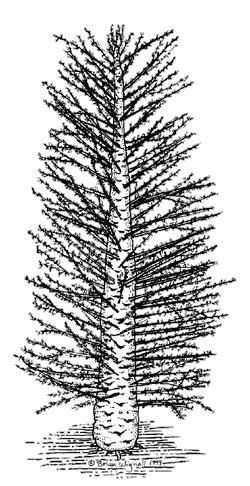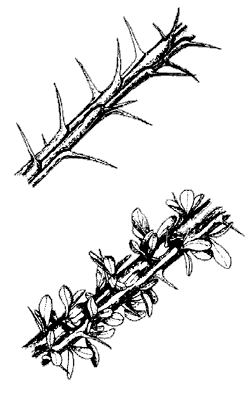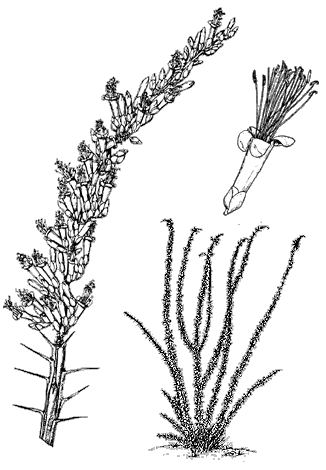Fouquieriaceae (ocotillo family)
The ocotillo family is a small one of only 11 species restricted to the warm-arid section of North America. Members of this family are odd-looking plants, some even bizarre. They are characterized by spiny stems with bundles of seasonal leaves at each spine. A few species are stem succulents, the rest barely semisucculent. The fouquierias have a curious parallel with the Didiereaceae. The few species of this exclusively Madagascan family closely resemble some of the ocotillos in growth habit, differing from them in growing much larger and having succulent leaves. The didiereas are distantly related to the cacti and not at all to the ocotillos, so this is an example of convergent evolution.
Fouquieria columnaris [Idria columnaris]
English name: boojum
Spanish name: cirio (a tall,
tapered candle)
Description
Boojum is a stem succulent with a single or branched, tapered primary stem to more than 60 feet (18 m) tall. Unbranched specimens resemble upside-down carrots. The succulent stems produce hundreds of horizontal, non- succulent, secondary branches armed with spines. The succulent stems elongate only in late winter and spring in direct relation to the amount of moisture received. Leaves and secondary branches may sprout any time moisture is available, but the plants are usually leafless and dormant in summer. Clusters of white, fragrant flowers are borne at the tops of primary stems from July to September.
 |  |
Range
This plant is nearly endemic to central Baja California, where the desert climate is moderated by the cool, moist winds off the Pacific Ocean. It is most common in the Vizcaino subdivision. There is a small disjunct population on the Gulf coast of Sonora, where an upwelling of cold water just offshore simulates the Pacific’s influence on the peninsula.
Notes
Baja California is so well-endowed with strange plants that its landscapes scarcely seem to belong to this planet. But even here, the boojum clearly stands out as the strangest of the strange. It is surely among the top ten most bizarre plants in the world, rivaling the Welwitschia of the Namib Desert, the baobabs of Africa and Australia, and the titan arum of Sumatra. A strange plant of a remote area it is, but not rare. It grows by the millions in the central third of the peninsula. Most plants are erect and unbranched, but some bend over and even form loops (see plate 21); others branch in odd patterns. On the windy Pacific coast they’re scarcely a foot tall, but grow many feet laterally, hugging the ground.
The English vernacular name comes from Lewis Carroll’s The Hunting of the Snark, a fictitious account of exploration of far-away places. The book contains a mythical creature called the “boojum” which inhabited distant shores. When explorer Godfrey Sykes encountered the plants growing on the desolate Sonoran coast in 1922, he was reminded of Carroll’s story and dubbed them boojums.
The boojum is essentially a succulent ocotillo (Fouquieria splendens). It differs from that close relative in being a winter grower. Earlier work by Robert Humphrey of the University of Arizona suggested that boojums grow only a few inches a year and that the tallest ones were up to 700 years old. But a more recent study indicates that their life spans may typically be a century or so. Of the boojums identified in photos taken in Baja California in 1905, not one was still present when the sites were revisited in the 1990s. And of those in photos taken in the 1950s, very few were still present only 40 years later. Every few decades a given boojum population experiences a direct hit from a hurricane. Boojum, cardón, and senita are especially vulnerable to high winds and suffer significant losses of large individuals from these events. The tallest known boojum was discovered by Robert Humphrey in Montevideo Canyon near Bahia de Los Angeles in the 1970s; at the time it was 81 feet (24.6 m) tall. It grew several more feet during the next 20 years. In 1998 it and the 60 foot plus (more than 18 m) cardón next to it were gone. We returned to Montevideo Canyon in 2002 and relocated both the giant boojum and its huge cardón companion. It measured (by triangulation of its shadow) at about 81-82 feet tall, no apparent change in 20 years. The adjacent cardón looks nearly the same except for a single two-foot long new growth on one of its many stems.
At the time of the first draft of this manuscript, we knew only that boojums are pollinated by a variety of insects. Then Steven Buchmann and colleagues at the Carl Hayden Bee Research Center completed a detailed pollination study of this species and reported a fascinating story. While this plant is indeed pollinated by a large number of insects, in each of the 20 years of study, there was a very different array of species collected in the same boojum populations in Baja California and Sonora. Many species were not seen again for several years. These pollinators may be another example of temporal niche separation (see the section on drought evasion in the Plant Ecology chapter). The boojums flower every year, but different insect pollinators emerge in different years in response to as yet unknown environmental cues.
Fouquieria splendens
English names: ocotillo, coachwhip
Spanish names: ocotillo, albarda,
ocotillo del corral, barda
 |
Description
Ocotillo is a woody shrub 10 to 20 feet (3-6 m) tall. Long, thin, and nearly unbranched, spiny stems arise from a very short trunk or caudex. The stems range from nearly vertical to widely-spreading in different individuals. Dense spikes of tubular, red to red-orange flowers sprout from the stem tips in spring. The flowering season begins as early as February at the lowest elevations in the lowest- elevation and lowest-latitude desert habitats, and as late as May in the grassland and woodland habitats. At the higher elevations some plants bloom again in late summer or fall. Each population blooms for a month.
Range
Ocotillo is the most widespread species in the family. It is common in most of the Sonoran and Chihuahuan deserts and extends north to the southern Mohave Desert, south to central Mexico, and east to central Texas.
Notes
All species in this genus have primary and secondary leaves and stems. The primary stems elongate and produce leaves with stout petioles (leaf stalks). When the leaf blade falls off most of the petiole and the base of the leaf midrib become woody and form a spine. At the base of each spine is a growing point that produces only secondary leaves which lack petioles. These axillary growing points are the secondary “branches,”properly termed short shoots; they grow only a couple of millimeters long during many decades of producing leaves.
Though ocotillos look like (albeit weird) woody shrubs, they behave as if they were cam succulents. They have very shallow roots, as do succulents. Full-grown leaves are produced as quickly as within three days of a summer rain, and fall off after a couple of weeks of dry weather. This rapid leaf production suggests that the thin layer of moist, green tissue beneath the brown cuticle would have cam-idling metabolism (see “Plant Ecology of the Sonoran Desert Region”). But it doesn’t; it’s C3, as are the leaves. It photosynthesizes during the day in the dry season when the stems are leafless. The idling metabolism of ocotillo remains a scientific mystery.
Ocotillos exhibit an interesting correlation with elevation and geology—specifically, soil types. They occur at their highest elevations (6000 feet, 1800 m) on limestone and at their lowest (sea level) on granite. Desert vegetation in general extends about 1000 feet (300 m) higher in elevation on limestone; the reason is twofold. First, limestone weathers slowly without cracking and makes a very thin soil that favors drought- and sun-tolerant plants. Second, limestone has a high specific heat; it stores more heat than most other rocks and thus offers more frost protection on winter nights. At the lowest elevation extreme, ocotillos are limited by water rather than frost. Granite rock disintegrates to form a gravelly soil that creates a moisture-retaining mulch. At the limit of their ecological tolerance for aridity, ocotillos and some other plants can grow on granite, but not on other, drier soils.
The floral characteristics seem to point clearly to hummingbirds as the primary pollinator, but, as with the saguaro, the story is more complicated. Ocotillos are important to hummingbirds, but the reverse is less true. Several species of hummingbirds migrate northward through the desert in large numbers in spring on their way to breeding grounds as far north as Alaska. Ocotillo flowers are a crucial energy source for this migration, since it is the only desert hummingbird flower that blooms abundantly even in dry years. (Like the nectar-feeding bats, hummingbirds return south along the mountains in late summer, feeding on higher-elevation flowers.)
Many other animals will consume nectar if they can get to it, but their behavior and body forms usually make them ineffective pollinators compared to each plant’s primary flower visitors that have coevolved a symbiosis (mutually beneficial relationship) . The long tubes of ocotillo flowers tend to prevent animals with mouthparts shorter than hummingbirds from reaching the nectar at the bottom of the tubes. But some animals have learned to cheat—they steal the nectar (that is, they take the reward without performing the pollination service). Verdins and carpenter bees can often be seen visiting blooming ocotillos, slitting the flower tubes at their bases and sucking out the nectar. It was assumed that this behavior failed to transfer pollen among flowers, a failure demonstrated for other nectar thieves.
But there’s a twist in this story. Peter Scott and colleagues from Southern Indiana University discovered that hummingbirds rarely visit ocotillos in the Big Bend area of Texas. But carpenter bees do, and they transfer pollen effectively while crawling around on the inflorescences biting through the flower tubes. So at least in this population, what appears to be a nectar thief is in fact the major pollinator.
Antelope ground squirrels climb into the branches and feed on the flowers and seeds.
Ocotillo is used for fencing, house walls, and ramada roofs by Indians and ranchers. The cut, buried stems often root, creating a living fence. The flowers are soaked in cold water to make a refreshing beverage.